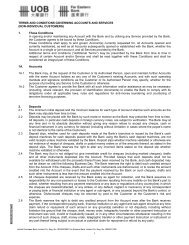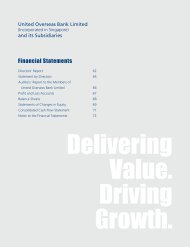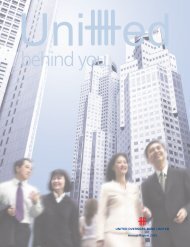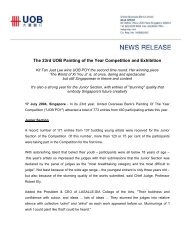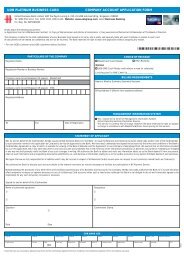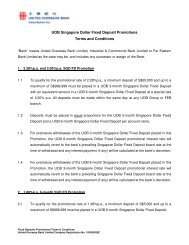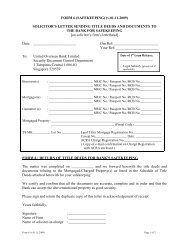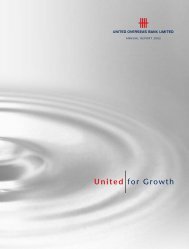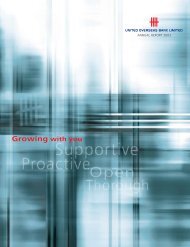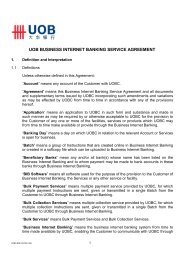(Thai) Annual Report 2005 - United Overseas Bank
(Thai) Annual Report 2005 - United Overseas Bank
(Thai) Annual Report 2005 - United Overseas Bank
Create successful ePaper yourself
Turn your PDF publications into a flip-book with our unique Google optimized e-Paper software.
Trends in the <strong>Thai</strong> <strong>Bank</strong>ing Environment<br />
<strong>2005</strong> saw the start of the actual consolidation among<br />
financial institutions under the Financial Sector Master<br />
Plan (FSMP) as envisioned by the Government. The UOB<br />
Group fully supports this FSMP and successfully integrated<br />
and merged its two banking subsidiaries in <strong>Thai</strong>land,<br />
the UOB Radanasin <strong>Bank</strong> PCL and <strong>Bank</strong> of Asia PCL, on<br />
28 November <strong>2005</strong>. The merged bank was renamed<br />
<strong>United</strong> <strong>Overseas</strong> <strong>Bank</strong> (<strong>Thai</strong>) PCL.<br />
New banking licenses were also issued under the FSMP<br />
to upgrade finance companies and credit fonciers to<br />
banks. Most of these new banks at this point in time are<br />
retail banks that focuses on personal financial services<br />
such as housing and mortgage loans, credit cards, personal<br />
loans and hire-purchase loans. Unsurprisingly, the retail<br />
consumer loan is also one of the fastest growing and<br />
most lucrative segments in the banking industry. This<br />
resulted in increased choices for retail customers and<br />
keener competition for banking products & services,<br />
deposits, as well as higher demand for experienced<br />
banking staff.<br />
Competition for certain segments of the retail customers<br />
was also from non-bank financial institutions, especially in<br />
the credit card, unsecured personal loan and hire-purchase<br />
of consumer goods. In <strong>2005</strong>, <strong>Bank</strong> of <strong>Thai</strong>land introduced<br />
measures to cap interest rates chargeable by these<br />
non-bank financial institutions.<br />
Overall demand for credit in the banking industry grew<br />
at a rate of about 6% in <strong>2005</strong> and the momentum is<br />
expected to continue, albeit at a slower pace, in 2006 amid<br />
a rising interest rate environment. As often experienced<br />
in a rising interest rate environment, there should be<br />
increased cautiousness in commercial monetary business<br />
decisions. Infrastructure project financing, investments<br />
and housing loans are expected to drive the demand for<br />
credit in 2006. On the other hand, deposits are expected<br />
to continue to grow steadily at about 7%-8%.<br />
<strong>Thai</strong> interest rates moved up significantly and quickly<br />
in the last quarter of <strong>2005</strong>, with the benchmark BOT<br />
14-day repo rate increasing by 100 basis points from<br />
3.25% in September <strong>2005</strong> to 4.25% as at end February<br />
2006. This increase narrowed the difference between<br />
the <strong>Thai</strong> interest rate and the US Federal Fund Reserve<br />
rate to 0.25%. Correspondingly, all banks in the banking<br />
industry raised their lending and deposit rates. <strong>Thai</strong> interest<br />
rates are widely expected to peak in mid 2006.<br />
All in all, the <strong>Thai</strong> banking environment is expected<br />
to be stable, with growth opportunities in line with<br />
expected overall economic growth of the country.<br />
<strong>United</strong> <strong>Overseas</strong> <strong>Bank</strong> (<strong>Thai</strong>) Public Company Limited 11




